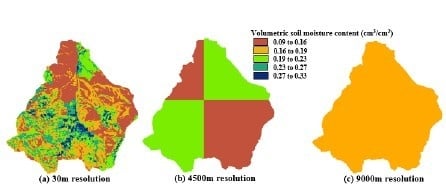Satellite Imagery-Based SERVES Soil Moisture for the Analysis of Soil Moisture Initialization Input Scale Effects on Physics-Based Distributed Watershed Hydrologic Modelling
Abstract
1. Introduction
2. Study Area
3. Data
4. Methodology
4.1. SERVES (Soil Moisture Estimation of Root Zone Through Vegetation Index-Based Evapotranspiration Fraction and Soil Properties) Model Formulation
- θ = soil moisture content;
- θfc = field capacity soil moisture content; and
- θwp = wilting point soil moisture content;
- i = any spatial location or grid/tin address for a numerical model.
Identification of SERVES Soil Physical Properties
4.2. GSSHA (Gridded Surface Sub-Surface Hydrological Analysis) Model
- K(θ) = soil moisture dependent hydraulic conductivity of the soil (m/s);
- Ks = saturated hydraulic conductivity of the soil (m/s);
- θ = water content of the soil;
- θs = saturated water content of the soil;
- θr = residual water content of the soil; and
- λ = is soil distribution index.
- Voln+1 = the updated volume of water in the soil layer (m3);
- Voln = the volume of water in the soil layer at the time of the last update (m3);
- Δt = the amount of time that has elapsed since the last updates (s);
- Inf = the infiltration rate (m/s);
- Rech = the groundwater recharge rate (m/s);
- Acell = the surface area of the cell (m2);
- AE = the actual evapotranspiration (m/s).
5. Results and Discussion
5.1. SERVES Estimated Initial Soil Moisture
5.1.1. Verification of SERVES Estimated Soil Moisture
5.1.2. Development of Soil Moisture Initial Condition
5.2. Watershed Hydrological Model Development and Parameter Value Identification
5.2.1. Model Development
5.2.2. Model Calibration
5.3. Disparity in Parameter Identification Scale and Moisture Initial Condition Application Scale
5.3.1. Resampling of Initial Soil Moisture
5.3.2. Inconsistency in Simulated Discharge
5.3.3. Inconsistency in the Parameter Values
Readjustment of Either Hydraulic Conductivity Value or Soil Moisture Value
5.3.4. Inconsistency in the Distribution of Simulated Soil Moisture State
6. Conclusions
Author Contributions
Funding
Acknowledgments
Conflicts of Interest
References
- Berg, A.; Lintner, B.; Findell, K.; Giannini, A. Soil moisture influence on seasonality and large-scale circulation in simulations of the West African Monsoon. J. Clim. 2017, 30, 2295–2317. [Google Scholar] [CrossRef]
- Kang, Y.; Khan, S.; Ma, X. Climate change impacts on crop yield, crop water productivity and food security—A review. Prog. Nat. Sci. 2009, 19, 1665–1674. [Google Scholar] [CrossRef]
- Mananze, S.; Pôças, I.; Cunha, M. Agricultural drought monitoring based on soil moisture derived from the optical trapezoid model in Mozambique. J. Appl. Remote Sens. 2019, 13, 024519. [Google Scholar] [CrossRef]
- Pradhan, N. Estimating growing-season root zone soil moisture from vegetation index-based evapotranspiration fraction and soil properties in the Northwest Mountain region, USA. Hydrol. Sci. J. 2019, 64, 771–788. [Google Scholar] [CrossRef]
- Parajka, J.; Naeimi, V.; Blöschl, G.; Wagner, W.; Merz, R.; Scipal, K. Assimilating scatterometer soil moisture data into conceptual hydrologic models at the regional scale. Hydrol. Earth Syst. Sci. 2006, 10, 353–368. [Google Scholar] [CrossRef]
- Silvestro, F.; Gabellani, S.; Rudari, R.; Delogu, F.; Laiolo, P.; Boni, G. Uncertainty reduction and parameter estimation of a distributed hydrological model with ground and remote-sensing data. Hydrol. Earth Syst. Sci. 2015, 19, 1727–1751. [Google Scholar] [CrossRef]
- Sutanudjaja, E.H.; van Beek, L.P.H.; de Jong, S.M.; van Geer, F.C.; Bierkens, M.F.P. Calibrating a large-extent highresolution coupled groundwater-land surface model using soil moisture and discharge data. Water Resour. Res. 2014, 50, 687–705. [Google Scholar] [CrossRef]
- Wanders, N.; Bierkens, M.F.P.; Jong, S.M.; Roo, A.; Karssenberg, D. The benefits of using remotely sensed soil moisture in parameter identification of large-scale hydrological models. Water Resour. Res. 2014, 50, 6874–6891. [Google Scholar] [CrossRef]
- Pradhan, N.R.; Ogden, F.L. Development of a one-parameter variable source area runoff model for ungauged basins. Adv. Water Resour. 2010, 33, 572–584. [Google Scholar] [CrossRef]
- Western, A.W.; Grayson, R.B.; Green, T.R. The Tarrawarra project: High resolution spatial measurement, modeling and analysis of soil moisture and hydrological response. Hydrol. Process. 1999, 13, 633–652. [Google Scholar] [CrossRef]
- Kerr, Y.; Waldteufel, P.; Richaume, P.; Wigneron, J.P.; Ferrazzoli, P.; Mahmoodi, A.; Al Bitar, A.; Cabot, F.; Gruhier, C.; Juglea, S.E.; et al. The SMOS soil moisture retrieval algorithm. IEEE Trans. Geosci. Remote Sens. 2012, 50, 1384–1403. [Google Scholar] [CrossRef]
- Naeimi, V.; Scipal, K.; Bartalis, Z.; Hasenauer, S.; Wagner, W. An improved soil moisture retrieval algorithm for ERS and METOP scatterometer observations. IEEE Trans. Geosci. Remote Sens. 2009, 47, 1999–2013. [Google Scholar] [CrossRef]
- Pan, M.; Sahoo, A.K.; Wood, E.F. Improving soil moisture retrievals from a physically-based radiative transfer model. Remote Sens. Environ. 2014, 140, 130–140. [Google Scholar] [CrossRef]
- Yueh, S.; O’Neill, P.E.; Kellogg, K.H.; Allen, A.; Bindlish, R.; Brown, M.; Chan, S.; Colliander, A.; Crow, W.T.; Das, N.; et al. SMAP Handbook—Soil Moisture Active Passive: Mapping Soil Moisture and Freeze/Thaw from Space; JPL Publication: Pasadena, CA, USA, 2014; 180p. [Google Scholar]
- López-Vicente, M.; Álvarez, S. Influence of DEM resolution on modelling hydrological connectivity in a complex agricultural catchment with woody crops. Earth Surf. Process. Landf. 2018, 43, 1403–1415. [Google Scholar] [CrossRef]
- Pradhan, N.R.; Tachikawa, Y.; Takara, K. A downscaling method of topographic index distribution for matching the scales of model application and parameter identification. Hydrol. Process. 2006, 20, 1385–1405. [Google Scholar] [CrossRef]
- Pradhan, N.R.; Tachikawa, Y.; Takara, K. Downscaling methods of flow variables for scale invariant routing model. Annu. J. Hydraul. Eng. Jpn. Soc. Civ. Eng.-JSCE 2006, 50, 109–114. [Google Scholar] [CrossRef][Green Version]
- Pradhan, N.R.; Ogden, F.L.; Tachikawa, Y.; Takara, K. Scaling of slope, upslope area and soil water deficit: Implications for transferability and regionalization in topographic index modeling. Water Resour. Res. 2008, 44, W12421. [Google Scholar] [CrossRef]
- Tan, M.L.; Ficklin, D.L.; Dixon, B.; Ibrahim, A.L.; Yusop, Z.; Chaplot, V. Impacts of DEM resolution, source, and resampling technique on SWAT-simulated streamflow. Appl. Geogr. 2015, 63, 357–368. [Google Scholar] [CrossRef]
- Zhang, J.X.; Wu, J.Q.; Elliot, W.J.; Dun, S.; Chang, K.-T. Effects of DEM Resolution on WEPP Hydrologic and Erosion Prediction: A Case Study of Two Forest Watersheds in Northern Idaho. Trans. ASABE 2009, 52, 447–457. [Google Scholar] [CrossRef]
- Fu, S.; Sonnenborg, T.O.; Jensen, K.H.; He, X. Impact of precipitation spatial resolution on the hydrological response of an integrated distributed water resources model. Vadose Zone J. 2011, 10, 25–36. [Google Scholar] [CrossRef]
- Koren, V.I.; Finnerty, B.D.; Schaake, J.C.; Smith, M.B.; Seo, D.J.; Duan, Q.Y. Scale dependencies of hydrologic models to spatial variability of precipitation. J. Hydrol. 1999, 217, 285–302. [Google Scholar] [CrossRef]
- Ogden, F.L.; Julien, P.Y. Runoff model sensitivity to radar rainfall resolution. J. Hydrol. 1994, 158, 1–18. [Google Scholar] [CrossRef]
- Gao, Q.; Zribi, M.; Escorihuela, M.J.; Baghdadi, N. Synergetic use of Sentinel-1 and Sentinel-2 data for soil moisture mapping at 100 m resolution. Sensors 2017, 17, 1966. [Google Scholar] [CrossRef] [PubMed]
- El Hajj, M.; Baghdadi, N.; Zribi, M.; Bazzi, H. Synergic Use of Sentinel-1 and Sentinel-2 Images for Operational Soil Moisture Mapping at High Spatial Resolution over Agricultural Areas. Remote Sens. 2017, 9, 1292. [Google Scholar] [CrossRef]
- Bauer-Marschallinger, B.; Freeman, V.; Cao, S.; Paulik, C.; Schaufle, S.; Stachl, T.; Modanesi, S.; Massari, C.; Ciabatta, L.; Brocca, L.; et al. Toward global soil moisture monitoring with Sentinel-1: Harnessing assets and overcoming obstacles. IEEE Trans. Geosci. Remote Sens. 2019, 57, 520–539. [Google Scholar] [CrossRef]
- Zribi, M.; Gorrab, A.; Baghdadi, N.; Lili-Chabaane, Z.; Mougenot, B. Influence of radar frequency on the relationship between bare surface soil moisture vertical profile and radar backscatter. IEEE Geosci. Remote Sens. Lett. 2013, 11, 848–852. [Google Scholar] [CrossRef]
- USDA (US Department of Agriculture). National Engineering Handbook; Irrigation Guide, Natural Resources Conservation Service; USDA: Washington, DC, USA, 1997; part 652.
- Downer, C.W.; Ogden, F.L. Gridded Surface Subsurface Hydrologic Analysis (GSSHA) User’s Manual, Version 1.43 for Watershed Modeling System 6.1; ERDC/CHL SR-06-1; System Wide Water Resources Program, Coastal and Hydraulics Laboratory, U.S. Army Corps of Engineers, Engineer Research and Development Center: Vicksburg, MS, USA, 2006; 207p. [Google Scholar]
- Ogden, F.L.; Pradhan, N.R.; Downer, C.W.; Zahner, J.A. Relative importance of impervious area, drainage density, width function and subsurface storm drainage on flood runoff from an urbanized catchment. Water Resour. Res. 2011, 47, 2011. [Google Scholar] [CrossRef]
- Pradhan, N.R.; Downer, C.W.; Johnson, B.E. A Physics Based Hydrologic Modeling Approach to Simulate Non-point Source Pollution for the Purposes of Calculating TMDLs and Designing Abatement Measures. In Practical Aspects of Computational Chemistry III; Springer: Berlin, Germany, 2014; pp. 249–282. [Google Scholar]
- Pradhan, N.R.; Loney, D. An analysis of the unit hydrograph peaking factor: A case study in Goose Creek Watershed, Virginia. J. Hydrol. Reg. Stud. 2018, 15, 31–48. [Google Scholar] [CrossRef]
- Pradhan, N.R.; Downer, C.; Marchinko, S. Catchment Hydrological Modeling with Soil Thermal Dynamics during Seasonal Freeze-Thaw Cycles. Water 2019, 11, 116. [Google Scholar] [CrossRef]
- Slaughter, C.; Marks, D.; Flerchinger, G.N.; van Vactor, S.S.; Burgess, M. Thirty-five years of research data collection at the Reynolds Creek Experimental Watershed, Idaho, United States. Water Resour. Res. 2001, 37, 2819–2823. [Google Scholar] [CrossRef]
- Seyfried, M.; Harris, R.C.; Marks, D.G.; Jacob, B. A Geographic Data-Base for Watershed Research, Reynolds Creek Experimental Water-Shed; Technical Bulletin NWRC 2000-3; Northwest Watershed Research Center, US Department of Agriculture, Agricultural Research Service: Boise, ID, USA, 2000.
- Rawls, W.J.; Brakensiek, D.L.; Miller, N. Green-Ampt infiltration parameters from soils data. J. Hydraul. Eng. 1983, 109, 62–70. [Google Scholar] [CrossRef]
- USGS (US Geological Survey). Product Guide, Landsat Surface Reflectance Derived Spectral Indices; Version 3.6; Department of the Interior: Washington, DC, USA, 2017. [Google Scholar]
- LaHatte, W.C.; Pradhan, N.R. Analysis of SURRGO Data and Obtaining Soil Texture Classifications for Simulating Hydrologic Processes; ERDC/CHL CHETN-X-3; U.S. Army Engineer Research and Development Center: Vicksburg, MS, USA, 2016. [Google Scholar]
- Refsgard, J.C.; Storm, B. MIKE SHE. In Computer Models of Watershed Hydrology; Singh, V.P., Ed.; Water Resources Publications: Highlands Ranch, CO, USA, 1995. [Google Scholar]
- Green, W.H.; Ampt, G.A. Studies of soil physics: 1. Flow of air and water through soils. J. Agric. Sci. 1911, 4, 1–24. [Google Scholar]
- Ogden, F.L.; Saghafian, B. Green and Ampt Infiltration with redistribution. ASCE J. Irrig. Drain Eng. 1997, 123, 386–393. [Google Scholar] [CrossRef]
- Brooks, R.H.; Corey, A.T. Hydraulic Properties of Porous Media; hydrology paper 3; Colorado State University: Fort Collins, CO, USA, 1964. [Google Scholar]
- Engman, E.T. Roughness coefficients for routing surface runoff. J. Irrig. Drain. Eng. 1986, 112, 39–53. [Google Scholar] [CrossRef]
- Senarath, S.U.S.; Ogden, F.L.; Downer, C.W.; Sharif, H.O. On the calibration and verification of two-dimensional, distributed, Hortonian, continuous watershed models. Water Resour. Res. 2000, 36, 1495–1510. [Google Scholar] [CrossRef]
- Graham, C.B.; Barnard, H.R.; Kavanagh, K.L.; McNamara, J.P. Catchment scale controls temporal connection of transpiration and diel fluctuations in streamflow. Hydrol. Proces. 2012. [Google Scholar] [CrossRef]
- Flerchinger, G.N.; Deng, Y.; Cooley, K.R. Groundwater response to snowmelt in a mountainous watershed: Testing of conceptual model. J. Hydrol. 1993, 152, 201–214. [Google Scholar] [CrossRef]
- Manning, R. On the flow of water in open channels and pipes. Trans. Inst. Civ. Eng. Irel. 1891, 20, 161–207. [Google Scholar]
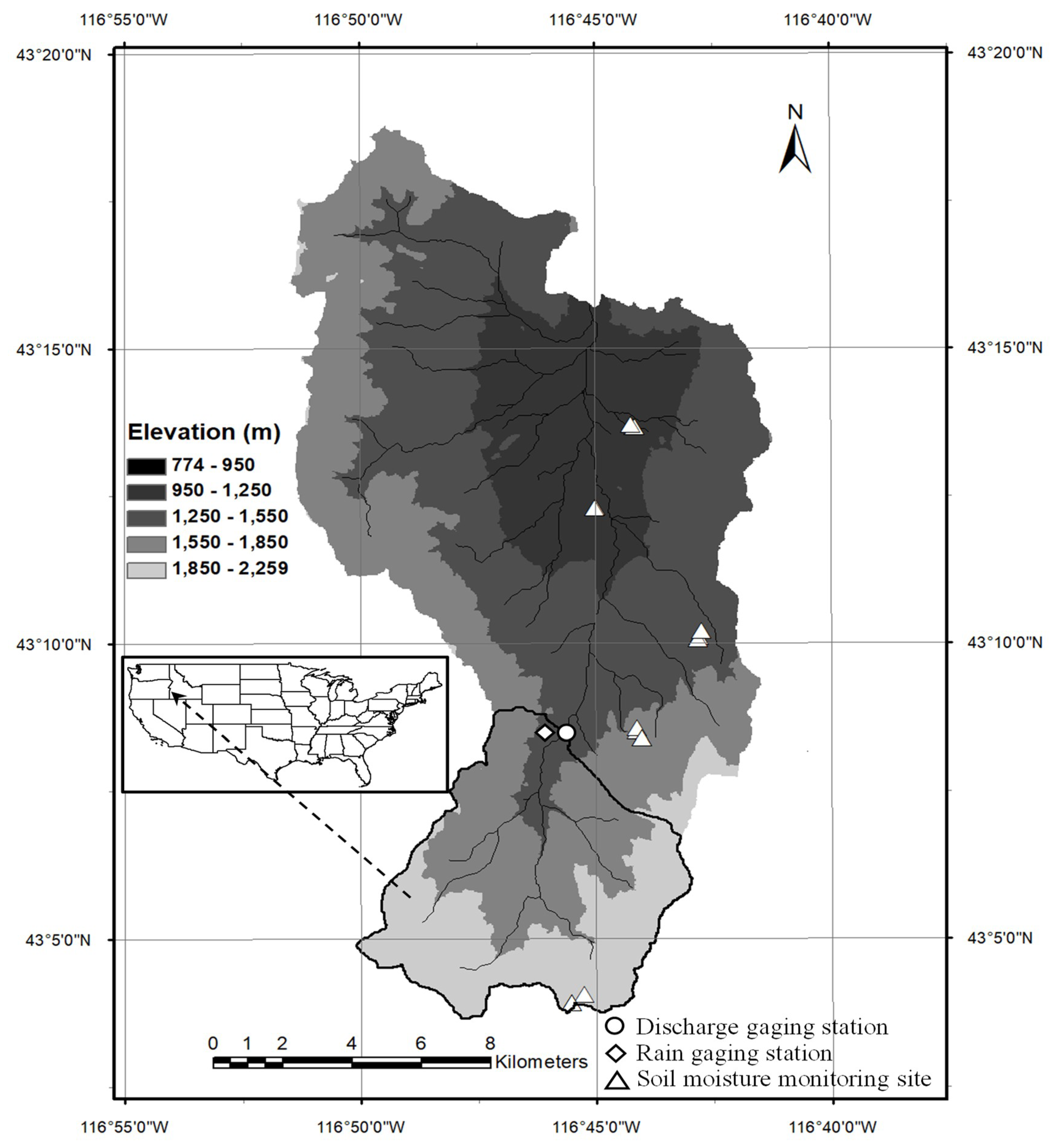
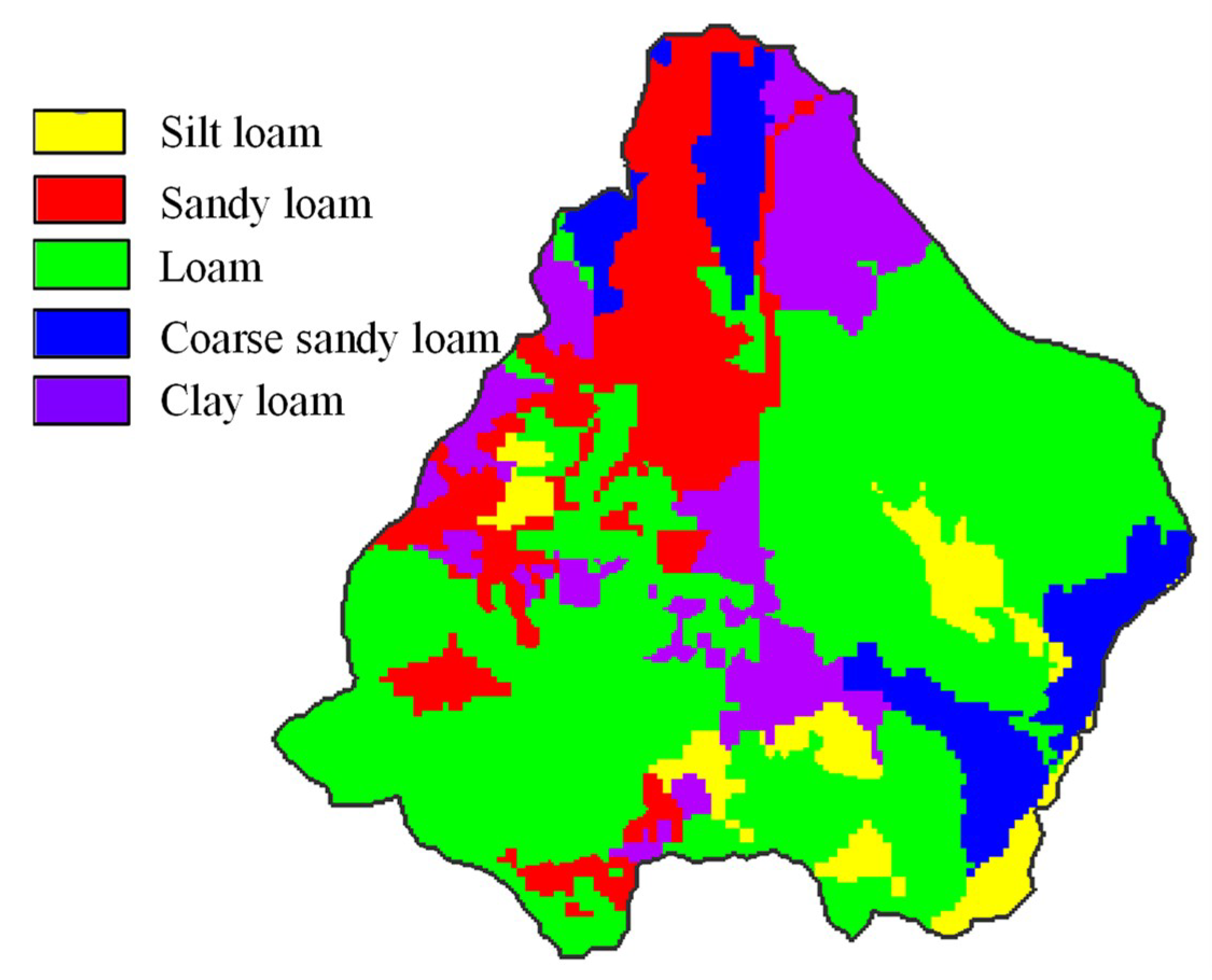
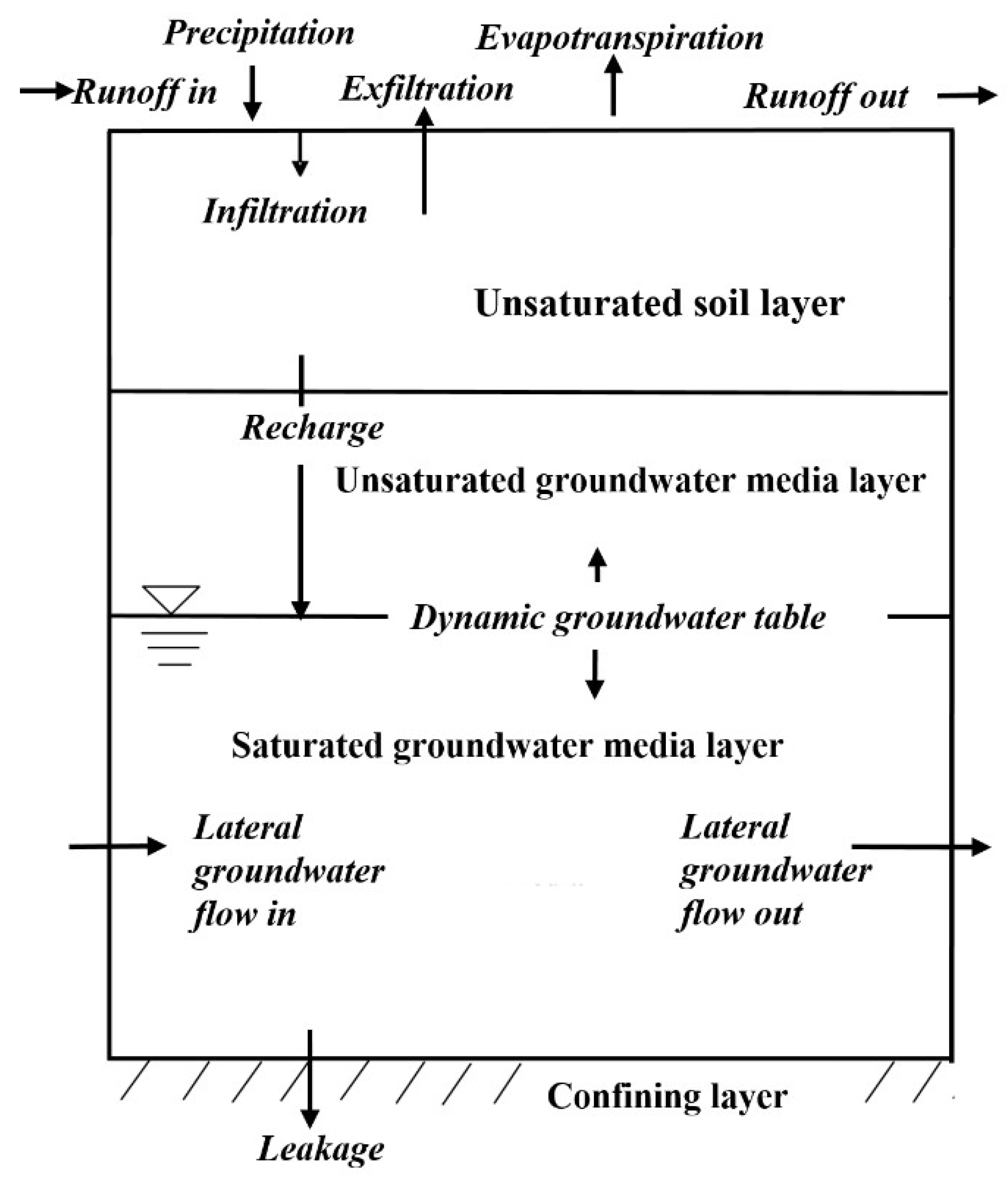
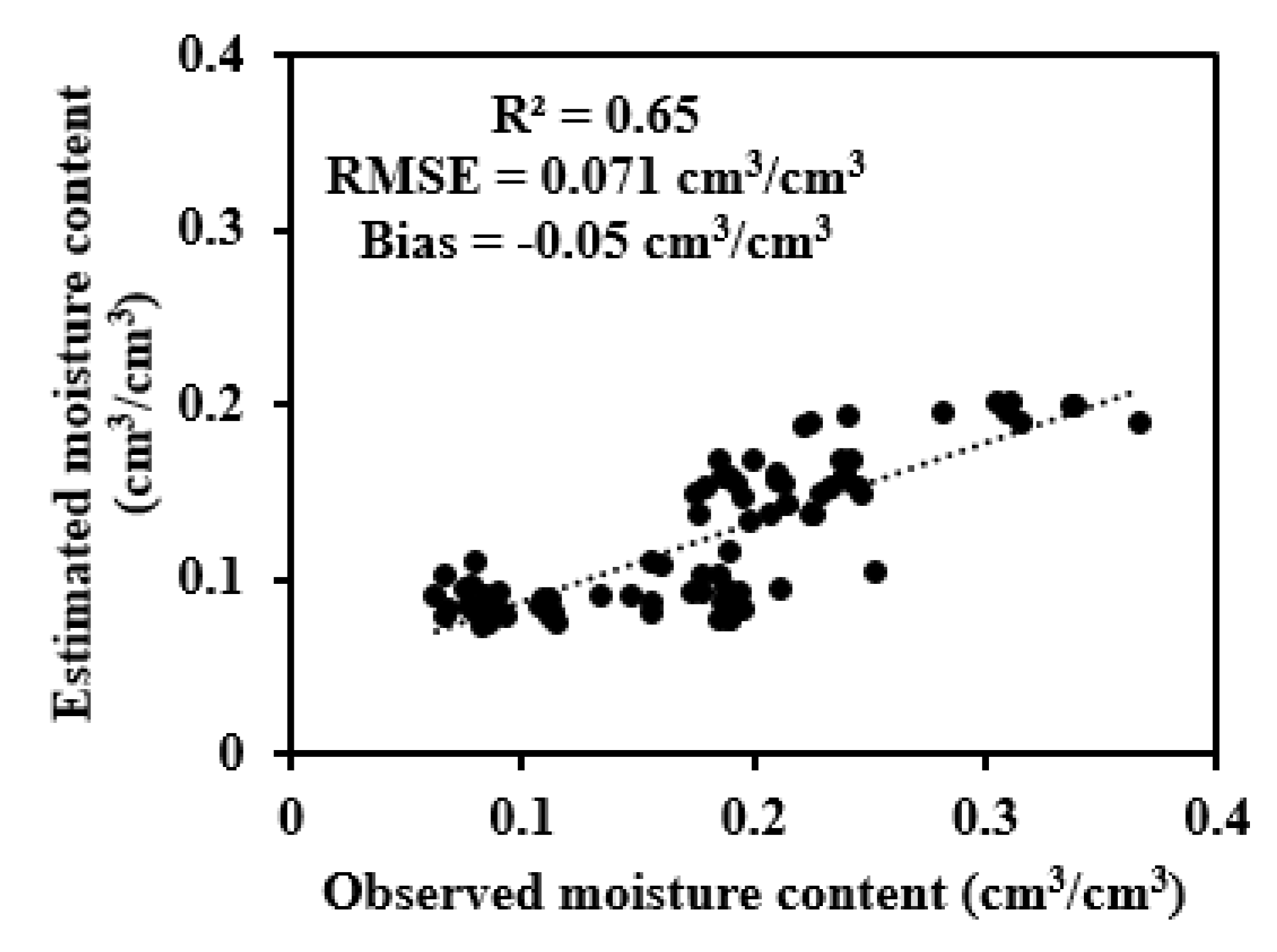
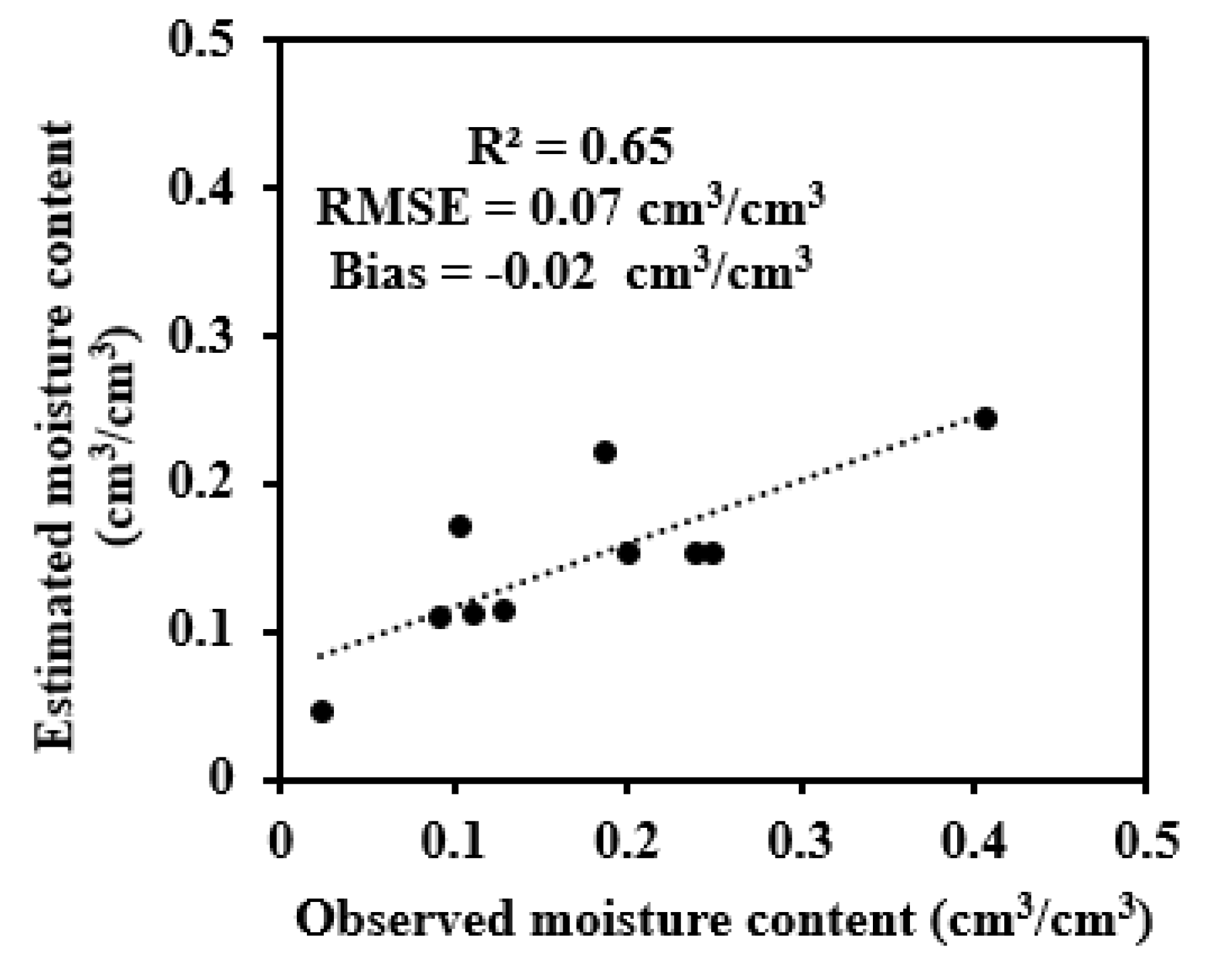
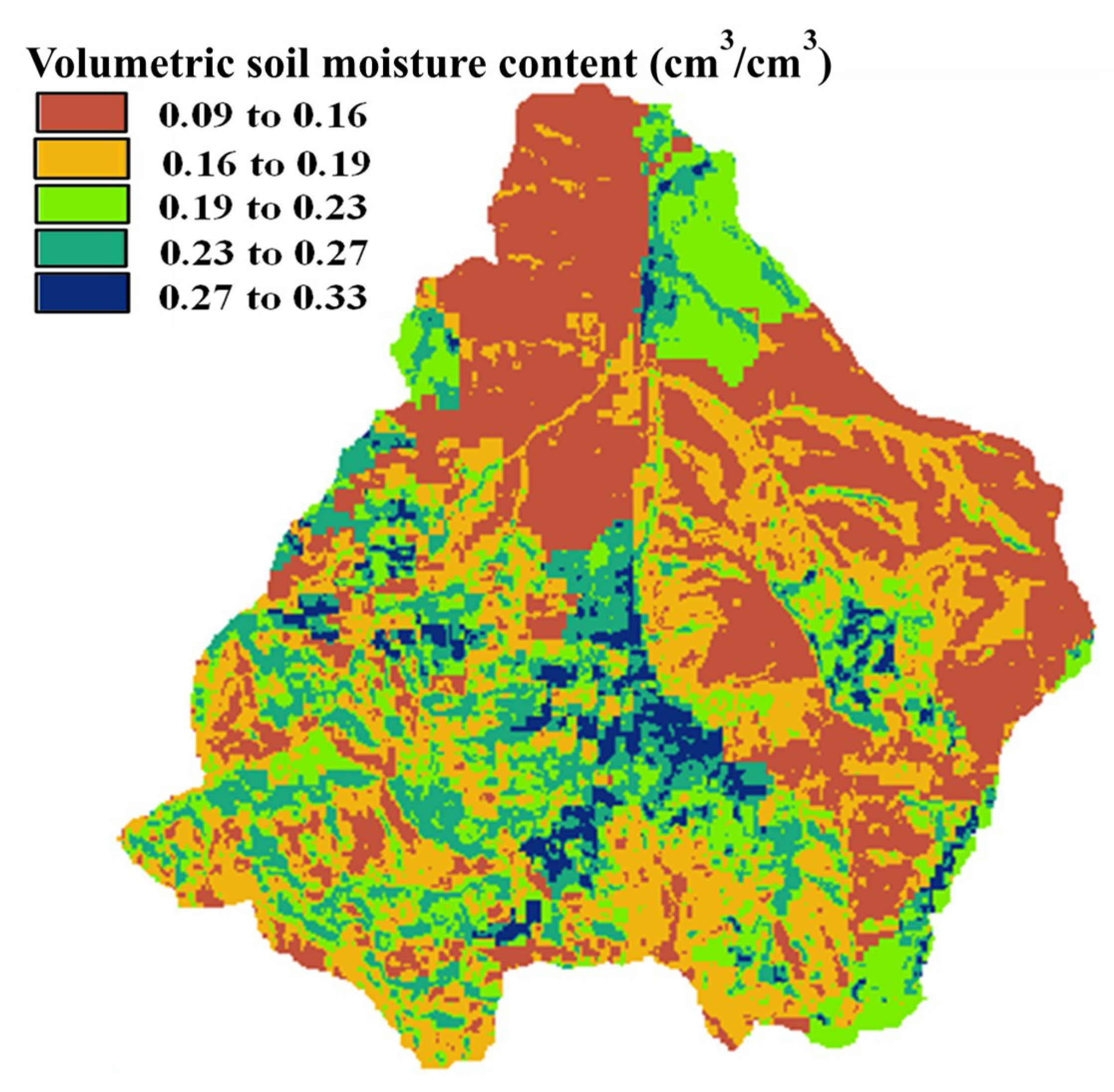
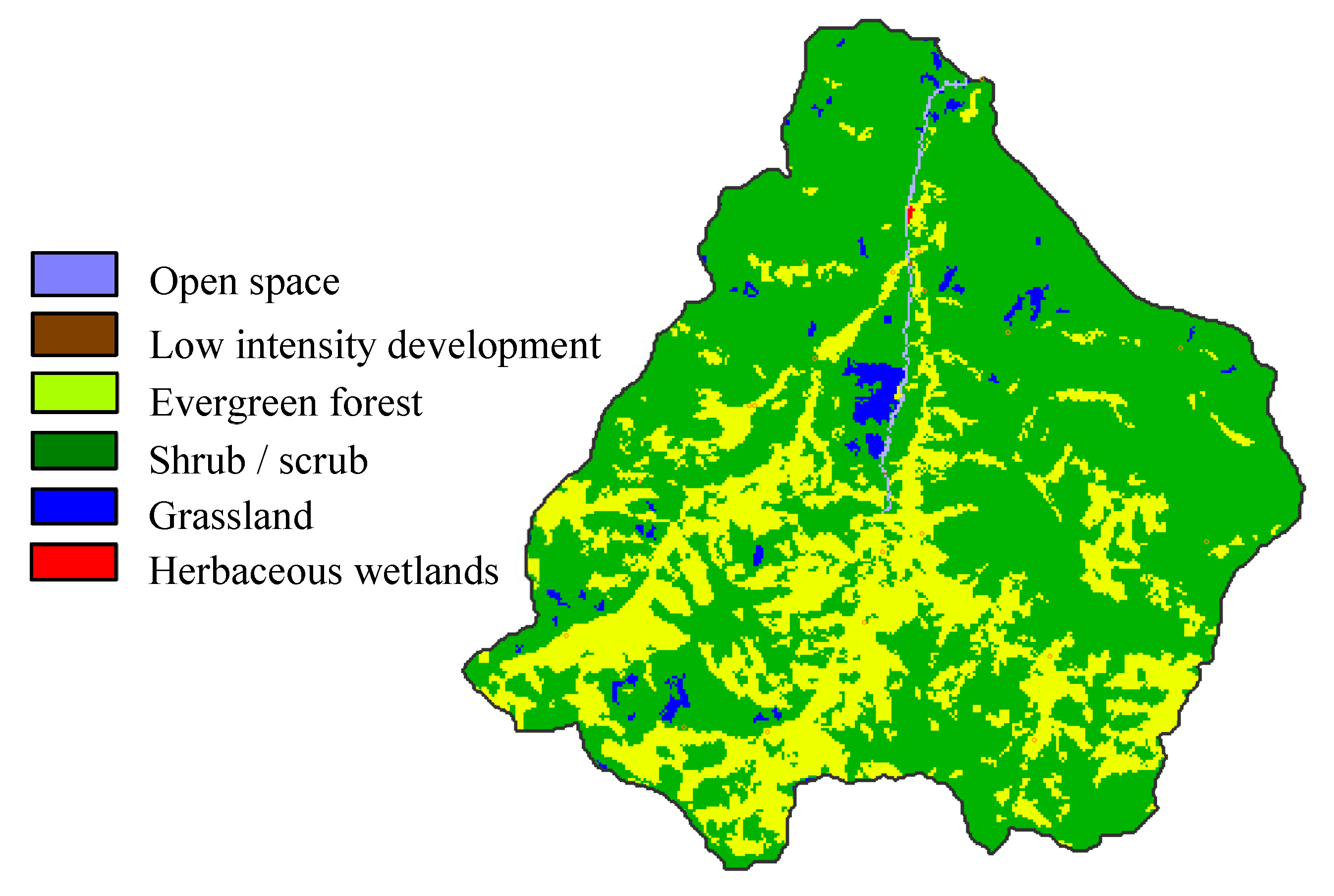
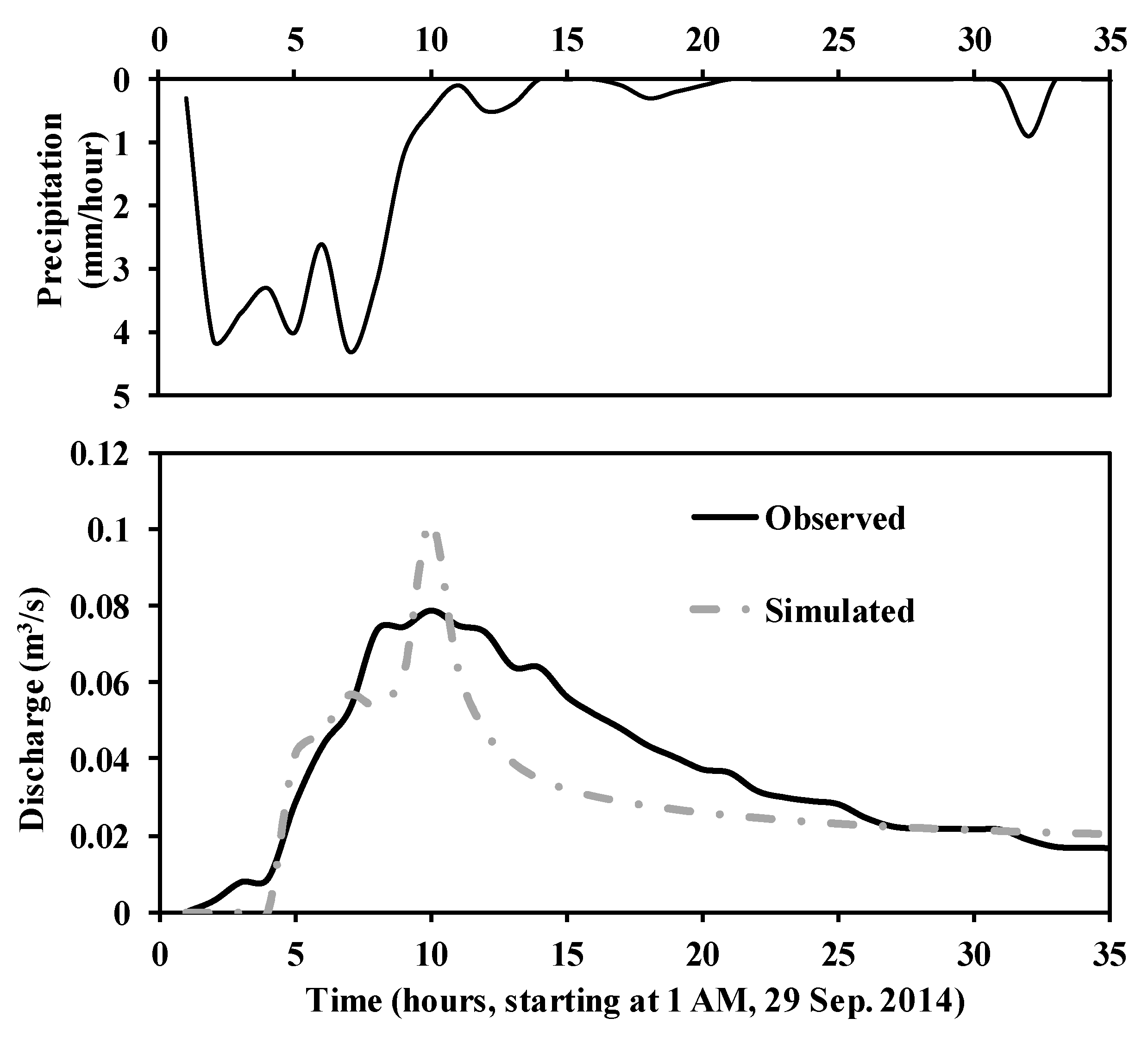
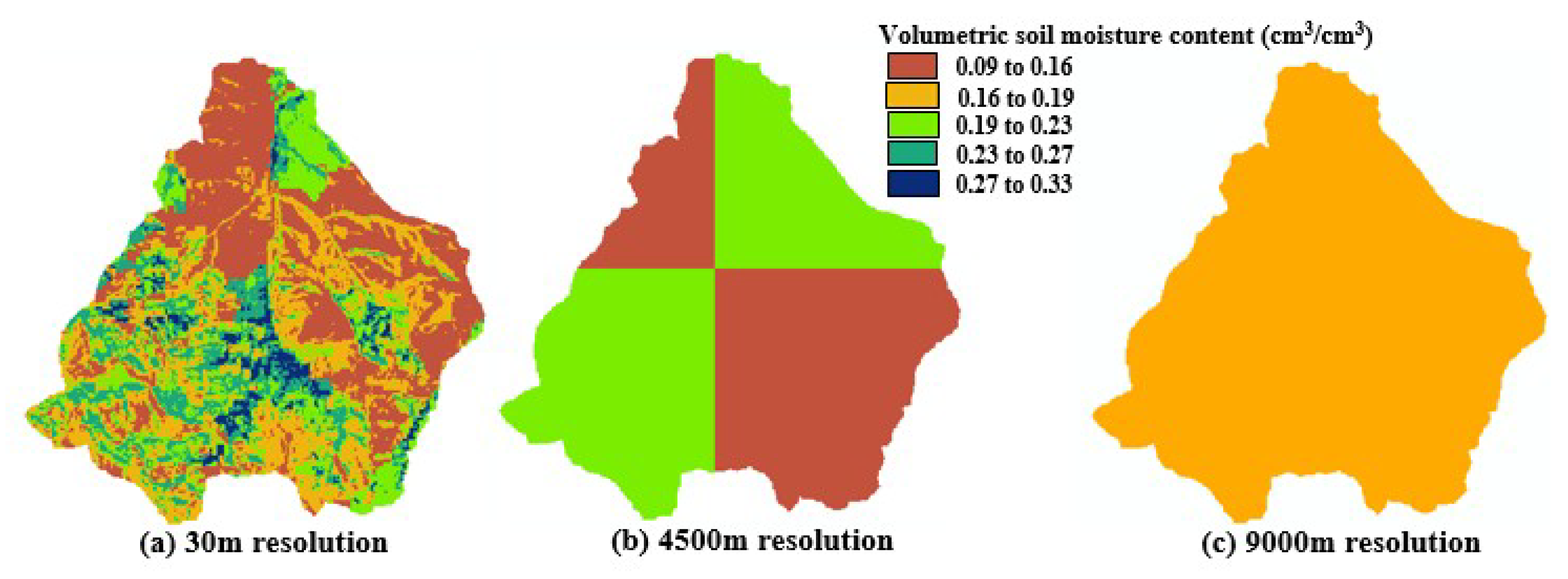
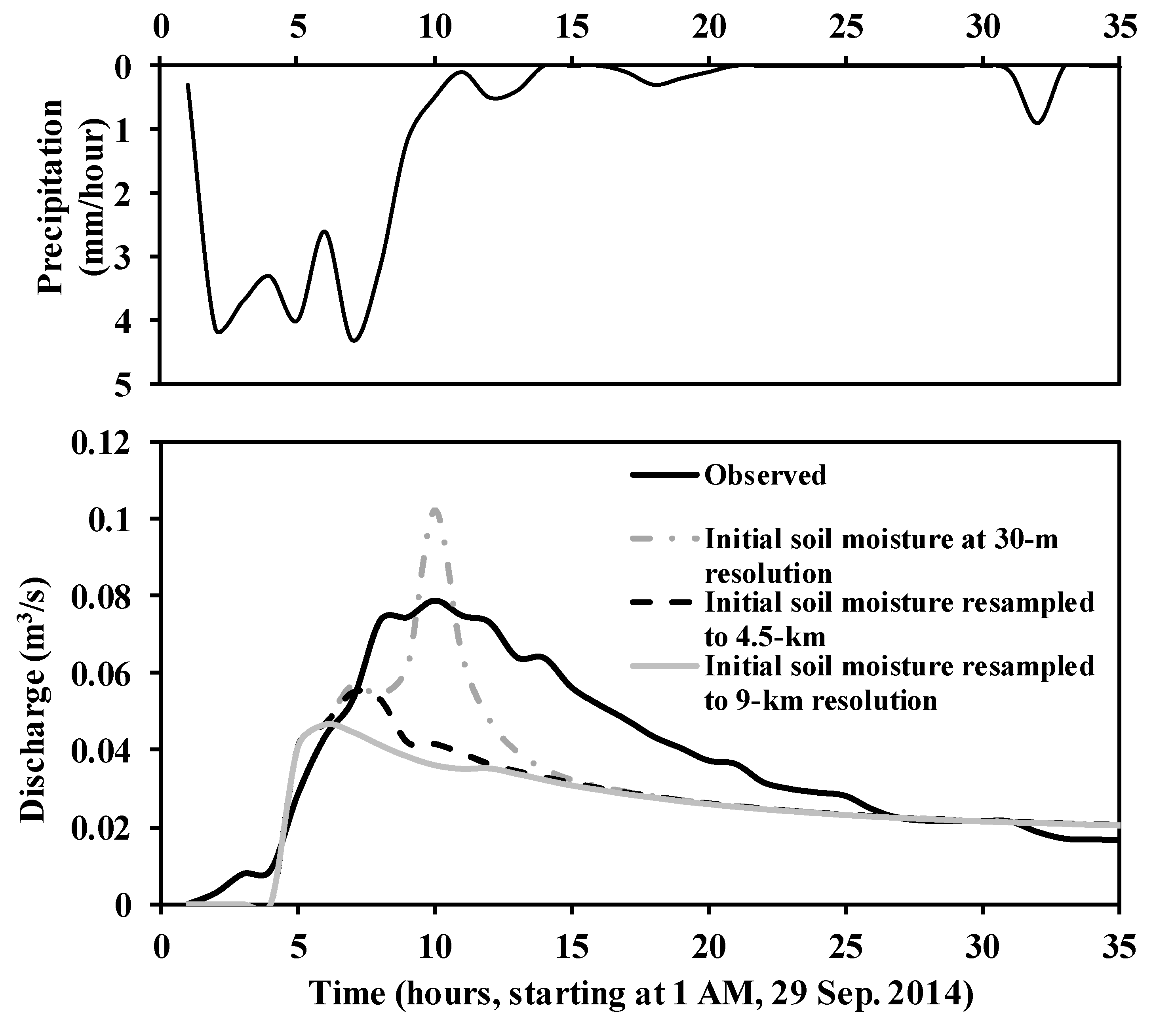
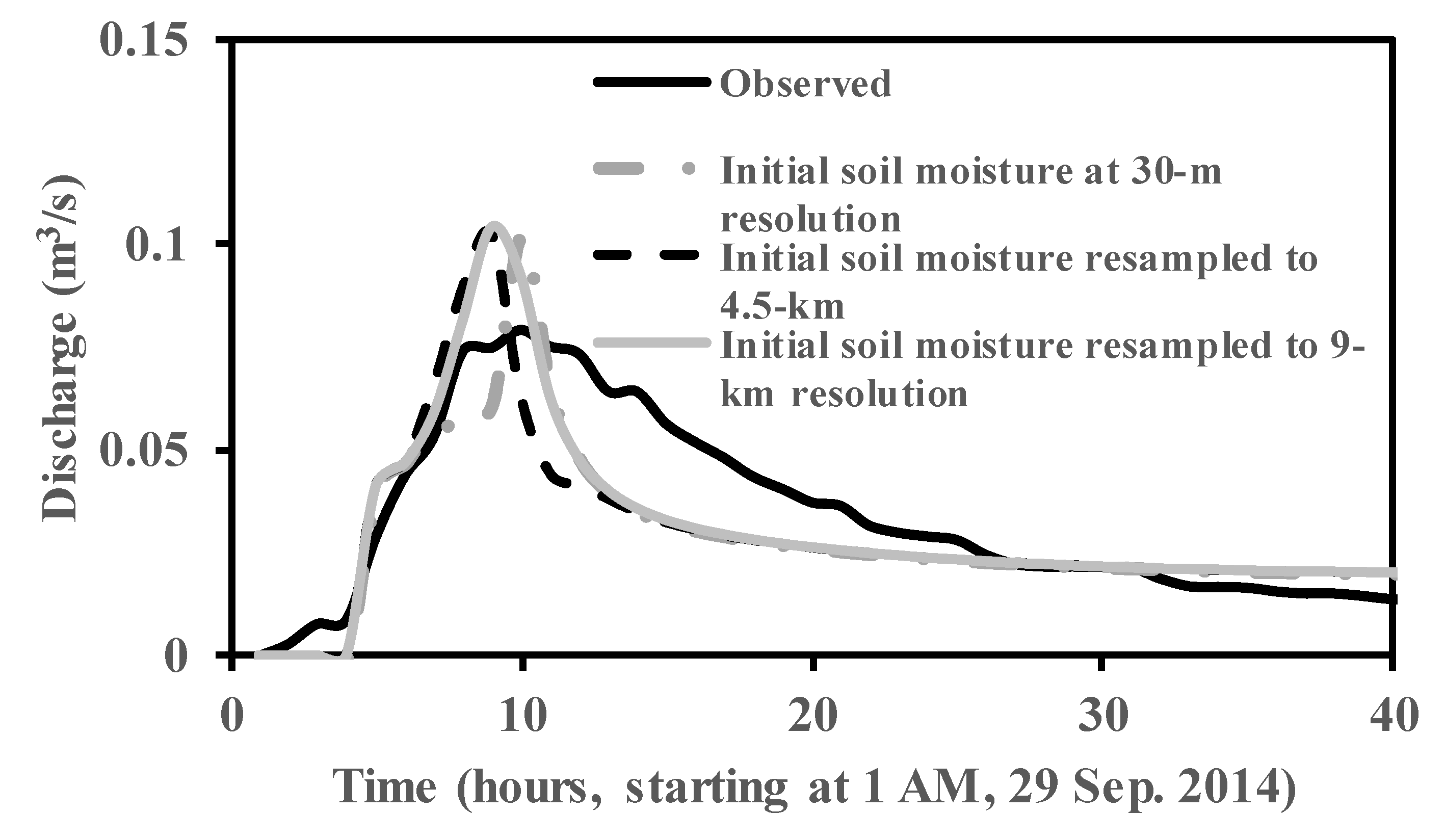

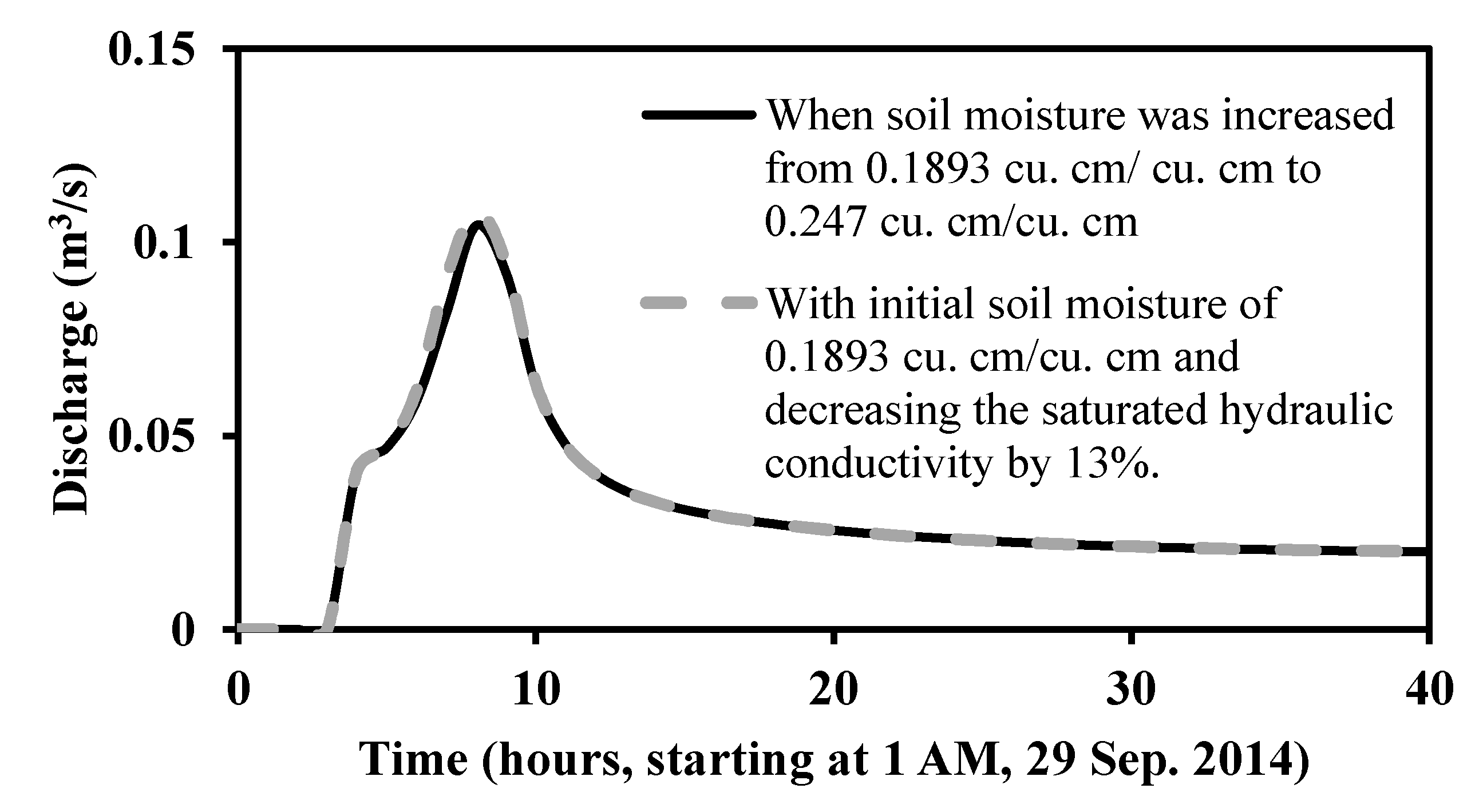
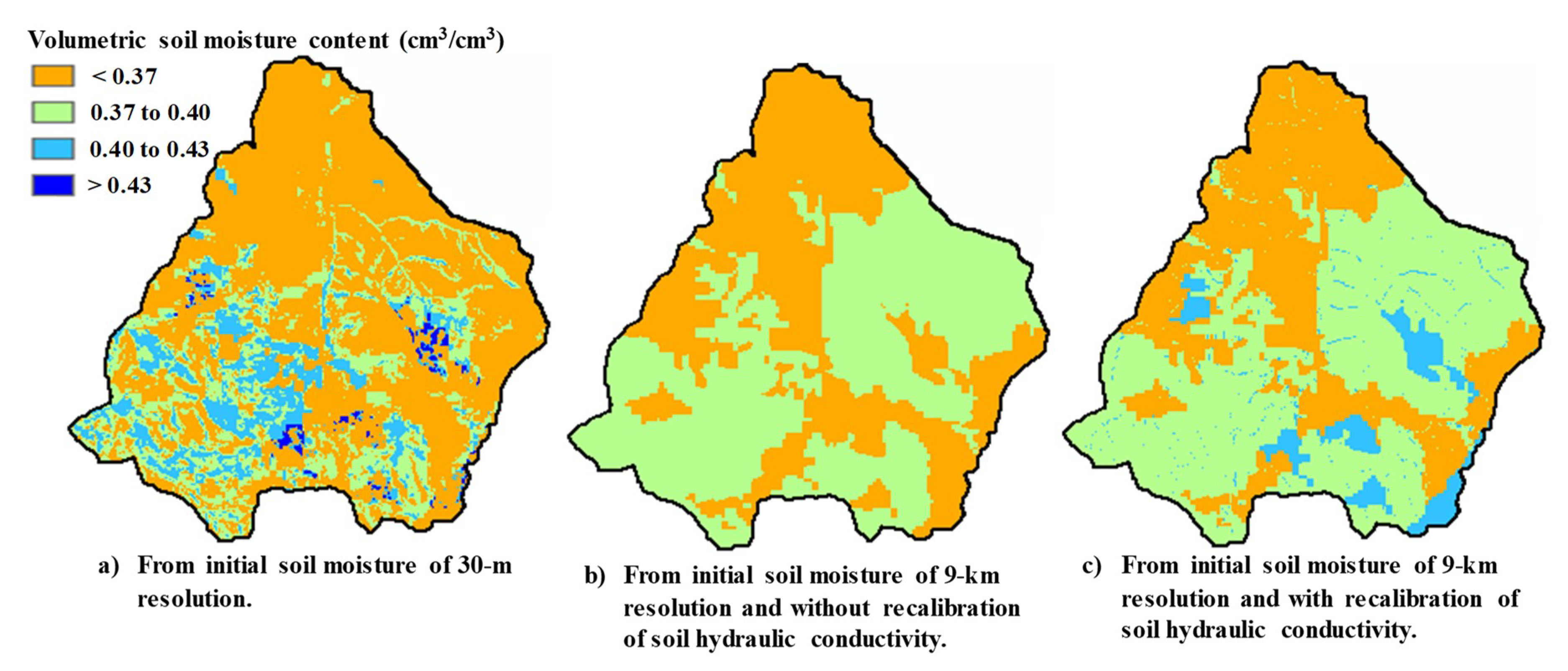

| Soil Type | Silt Loam | Sandy Loam | Loam | Coarse Sandy Loam | Clay Loam |
|---|---|---|---|---|---|
| Saturated hydraulic conductivity (cm/h) | 0.199 | 0.199 | 0.199 | 0.199 | 0.199 |
| Capillary head (cm) | 10.5 | 10.7 | 10.0 | 10.7 | 10.7 |
| Porosity (m3/m3) | 0.48 | 0.41 | 0.43 | 0.41 | 0.39 |
| Pore distribution index (cm/cm) | 0.234 | 0.378 | 0.252 | 0.378 | 0.242 |
| Residual point (m3/m3) | 0.015 | 0.041 | 0.027 | 0.041 | 0.075 |
| Field capacity (m3/m3) | 0.33 | 0.207 | 0.270 | 0.207 | 0.318 |
| Wilting point (m3/m3) | 0.133 | 0.095 | 0.117 | 0.095 | 0.197 |
| Land Use Type | Manning’s Roughness Value |
|---|---|
| Open space | 0.09 |
| Low intensity development | 0.05 |
| Evergreen forest | 0.25 |
| Shrub/scrub | 0.45 |
| Grassland | 0.4 |
| Herbaceous wetlands | 0.15 |
| Soil Moisture Resolution Factor | % Decrease in the Hydraulic Conductivity Calibrated Value |
|---|---|
| 150 | 8.0 |
| 300 | 13.0 |
© 2020 by the authors. Licensee MDPI, Basel, Switzerland. This article is an open access article distributed under the terms and conditions of the Creative Commons Attribution (CC BY) license (http://creativecommons.org/licenses/by/4.0/).
Share and Cite
Pradhan, N.R.; Floyd, I.; Brown, S. Satellite Imagery-Based SERVES Soil Moisture for the Analysis of Soil Moisture Initialization Input Scale Effects on Physics-Based Distributed Watershed Hydrologic Modelling. Remote Sens. 2020, 12, 2108. https://doi.org/10.3390/rs12132108
Pradhan NR, Floyd I, Brown S. Satellite Imagery-Based SERVES Soil Moisture for the Analysis of Soil Moisture Initialization Input Scale Effects on Physics-Based Distributed Watershed Hydrologic Modelling. Remote Sensing. 2020; 12(13):2108. https://doi.org/10.3390/rs12132108
Chicago/Turabian StylePradhan, Nawa Raj, Ian Floyd, and Stephen Brown. 2020. "Satellite Imagery-Based SERVES Soil Moisture for the Analysis of Soil Moisture Initialization Input Scale Effects on Physics-Based Distributed Watershed Hydrologic Modelling" Remote Sensing 12, no. 13: 2108. https://doi.org/10.3390/rs12132108
APA StylePradhan, N. R., Floyd, I., & Brown, S. (2020). Satellite Imagery-Based SERVES Soil Moisture for the Analysis of Soil Moisture Initialization Input Scale Effects on Physics-Based Distributed Watershed Hydrologic Modelling. Remote Sensing, 12(13), 2108. https://doi.org/10.3390/rs12132108




